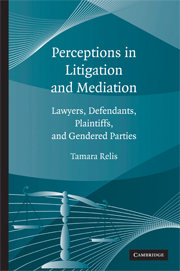Book contents
- Frontmatter
- Contents
- List of tables
- List of figures
- List of abbreviations
- Acknowledgments
- 1 Introduction
- 2 Great misconceptions or disparate perceptions of plaintiffs' litigation aims?
- 3 The voluntary versus mandatory mediation divide
- 4 Consequences of power: Legal actors versus disputants on defendants' attendance at mediation
- 5 Actors' mediation objectives: How lawyers versus parties plan to resolve their cases short of trial
- 6 Perceptions during mediations
- 7 Parallel views on mediators and styles
- 8 Conclusion: The parallel understandings and perceptions in case processing and mediation
- Bibliography
- Index
7 - Parallel views on mediators and styles
Published online by Cambridge University Press: 21 August 2009
- Frontmatter
- Contents
- List of tables
- List of figures
- List of abbreviations
- Acknowledgments
- 1 Introduction
- 2 Great misconceptions or disparate perceptions of plaintiffs' litigation aims?
- 3 The voluntary versus mandatory mediation divide
- 4 Consequences of power: Legal actors versus disputants on defendants' attendance at mediation
- 5 Actors' mediation objectives: How lawyers versus parties plan to resolve their cases short of trial
- 6 Perceptions during mediations
- 7 Parallel views on mediators and styles
- 8 Conclusion: The parallel understandings and perceptions in case processing and mediation
- Bibliography
- Index
Summary
“Party self-determination and informed consent dictate that knowledgeable choices should be made about which process to select for resolving one's dispute. Choice entails having distinct options among an array of possibilities. Self-determination is among the pillars of the mediation process.”
Love and Kovach (2000, p. 300)In line with the chronological ordering of the chapters relating to litigation-track case processing events from contextual and pre-mediation issues (chapters two to five) to those of actual mediations (chapters six and seven), this chapter examines a final facet of the mediation experience for the actors involved: that of mediators and their styles. For those actors whose cases settled due to mediation, the process and all it entailed represented the end of case processing. Even for those cases that did not settle, mediation was likely to have been the last such gathering of all or most actors involved in these disputes prior to trial, bilateral lawyer settlement, or case abandonment.
Actors' perceptions of mediations were intertwined with their views on mediators. Mediators were often perceived as the core of mediations – even synonymous with “mediation” itself. However, there were material differences in views on mediators' performances. This reflected not only subjective perceptions but also objective realities in mediation, as will be seen. What gave certain mediators “the power” to make mediation worthwhile, while others were left to try to make the best of things?
- Type
- Chapter
- Information
- Perceptions in Litigation and MediationLawyers, Defendants, Plaintiffs, and Gendered Parties, pp. 197 - 225Publisher: Cambridge University PressPrint publication year: 2009

